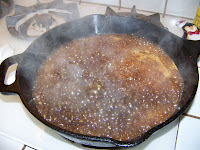One thing every kitchen should have is a good cast iron skillet. I did not have one until about three years ago, and now I wouldn’t be without one.
Iron cookware has been used for hundreds of years and continues to pass the test of time because of its many cooking advantages. Iron can withstand very high temperatures, making it great for searing, pan-frying, and oven use. It also holds heat very well so there are minimal temperature fluctuations when food is added to the pan.
Another great characteristic of iron skillets is their ability to be seasoned. With proper use and care, iron cookware develops a non-stick surface. This makes iron pots and pans suitable for cooking a wide-variety of foods including meat, eggs, casseroles, and some cakes. I’ve even used mine to make English muffins.
Cooking with an iron skillet also has nutritional advantages. During the cooking process, small amounts of iron leach out of the pan and into the food. Iron is an element that is required by the blood to carry oxygen throughout the body. Anemics are encouraged to use iron cookware.
One of the main disadvantages of iron cookware is that it is very heavy. Of course, this is partially what makes it so heat retentive.
The key to getting the most out of your iron cookware is proper use and care. If cared for properly, you should never have to replace an iron skillet. Season your iron cookware before the first use and at least once a year after that.
Seasoning Iron Cookware
Place cookware on the top rack of a cold oven with a baking sheet on the bottom rack. Turn the oven on to 350°. When the pan is warm (not hot) remove it from the oven and spread completely with vegetable shortening. Be sure to season all surfaces: inside, outside, bottom, and handle. Return to preheated oven and bake for 1 hour. Turn off heat and let cookware cool slightly in oven. Remove; wipe with paper towel.
When it comes to cleaning iron cookware, it needs some special attention to maintain its season. I never use soap on mine and never soak it (soaking can cause the iron to rust). If there is any cooked on food, I simply deglaze it. I then clean it with shortening and kosher salt which re-seasons it for the next use.
Deglazing Iron Cookware (to remove cooked-on food)
Heat the pan over medium-high heat. When it is really hot, add enough water to cover bottom of pan ¼-½ inch. Use a wooden spoon to scrape off cooked-on food. Pour water out. Note: this liquid is very flavorful and can be used in some dishes.
 |
| Cooked-on food remaining after sautéing chicken |
 |
| I even let this sit overnight to show how well this cleaning method works |
 |
| Getting the pan hot. Notice that the cooked-on grease is actually foaming. |
 |
| Use care when adding the water as it will steam immediately |
 |
| Scraping the food off |
Cleaning Iron Cookware
Heat pan over medium-high heat. Add a dollop of vegetable shortening and let melt. Add some kosher salt. Scrub with paper towels until clean, being careful of hot oil (can use tongs to hold paper towels). Quickly rinse with hot water. To dry, place in cold oven. Turn oven to 350°. Turn oven off when it reaches 350° and let pan cool in oven. If necessary, wipe with a little vegetable shortening before next use.
 |
| Melting the shortening |
 |
| Adding kosher salt. Kosher salt is coarser than table salt. |
 |
| Scrubbing with paper towels--this may be done with tongs |
 |
| Your pan should be black and shiny when finished |
What we have
Kimiko: I have a Lodge Logic 12 inch cast iron skillet (available here ). I've only had mine for a couple of months, but I love it! As with Sumiko's, I also wish it had a lid. One of the great things I love about cast iron is that it can be used on the stovetop and in the oven, so if you have something that you would normally cook on the stove, but want to put it in the oven to crisp up the top, you can easily do it. I'm also considering getting a smaller cast iron skillet to make smaller quantities and to make cornbread (the 12 inch spreads the batter too much, resulting in a very thin cornbread). If you're hesitant about getting a skillet because you don't have much storage space in your kitchen, you can store it in your oven.
). I've only had mine for a couple of months, but I love it! As with Sumiko's, I also wish it had a lid. One of the great things I love about cast iron is that it can be used on the stovetop and in the oven, so if you have something that you would normally cook on the stove, but want to put it in the oven to crisp up the top, you can easily do it. I'm also considering getting a smaller cast iron skillet to make smaller quantities and to make cornbread (the 12 inch spreads the batter too much, resulting in a very thin cornbread). If you're hesitant about getting a skillet because you don't have much storage space in your kitchen, you can store it in your oven.
What we use it for
- Fried rice
- Chicken
- Browning beef roasts
- Pork chops
- Stir-fry
- English muffins
- Cornbread
- Pancakes
- Breakfast potatoes


No comments:
Post a Comment